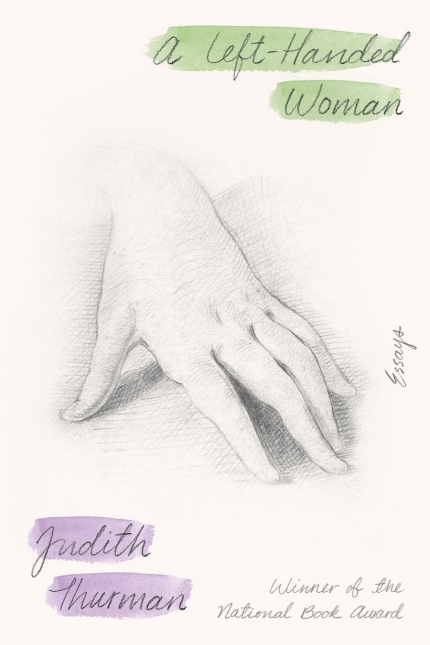A Left-Handed Woman: Essays
- By Judith Thurman
- Farrar, Straus and Giroux
- 432 pp.
- Reviewed by Patricia Schultheis
- January 30, 2023
The author explores myriad topics in this intelligent, captivating collection.

A Left-Handed Woman by New Yorker staff writer Judith Thurman deserves the top spot on anyone’s bedside book stack. Neither unremittingly didactic nor frothily superficial, these 38 essays and profiles are the perfect blend of keen observation, thorough research, and deft wordsmithing. “The writers I admire most never use a careless word. Their sentences are unimprovable,” Thurman writes, and in A Left-Handed Woman, she meets her own standards.
Loosely grouped into nine categories, her subjects range from the fashion designer Isabel Toledo to prehistoric cave art. But the entries are not progressive, so readers can easily jump around. Not interested in the bewitching British actress Charlotte Rampling (although this reviewer can’t imagine who wouldn’t be)? Fine! Perhaps “The Eye of the Needle,” Thurman’s profile of Ann Lowe, the Black designer of Jackie Kennedy’s wedding gown, will prove more interesting. Or, at the very least, more illuminating about racial inequities and one woman’s struggle to express herself despite them.
Lowe, who created confections for innumerable debutantes, had only an eighth-grade education but the eye of an artist coupled with the skill of a master fabricator. She traveled to Paris for the fashion shows of Balenciaga and Dior, and her own creations were featured in Vanity Fair and the Saturday Evening Post. But changing social mores and her own failing health caught up with her; in 1981, Lowe died blind and penniless. Thurman concludes her insightful profile with this terse observation: “Her vision outlived her sight.”
Epigrammatic endings are a hallmark of Thurman, who otherwise keeps herself in the background. Possessing both a polymath’s curiosity and an empath’s patience, she lets her subjects reveal themselves. Readers know she’s present — they see her at the Tuscan baptism of a friend’s baby and traipsing through Bergdorf Goodman with personal shopper Betty Halbreich — but her focus is mostly on what drives her subjects. What interests Thurman herself, she writes, is:
“What we bring with us — embedded in our flesh and bugging it; embedded in art and animating it — is the mystery of how we become who we are.”
The common thread here is the creative spirit, what impels her subjects to externalize their inner selves, or in the case of “Blue Yonder,” her essay on Amelia Earhart, what drove the aviatrix to become a self-created media darling.
Many of Thurman’s pieces are about fashion. She knows both couture’s nuts and bolts, such as tacking stiches and trapunto, and its importance as a societal placeholder. The clothes of the Chinese designer Guo Pei, she writes, “are an exalted form of livery, a uniform for women performing an old-fashioned role.”
But a mind like Thurman’s won’t allow a writer to linger in the atelier for long; in other sections, she ventures far afield from trompe-l’oeil flowers. “Speaking in Tongues” and “Deep Dives” are especially interesting. The former includes two essays about vanishing languages and polyglots, individuals who have mastered many languages, some of which no longer are spoken, such as Selk’nam, the language of the Indigenous people of southern Chile. Within the same essay, Thurman seamlessly knits together a profile of Keyuk, a 21-year-old who calls himself the “the world’s only speaker of Selk’nam,” ethnobotany, the Endangered Language Alliance in lower Manhattan, the Mohawk Nation, and Luis Miguel Rojas-Berscia, another polyglot whom Thurman accompanies to Malta as he learns Maltese.
The section labeled “Deep Dives” contains an essay on the prehistoric cave art of southern France and northern Spain. Here, as she does throughout A Left-Handed Woman, Thurman doesn’t permit herself to muse about the meaning of the caves’ bison, stags, ibex, horses, and mammoths, but rather defers to the archaeologists, ethnologists, geneticists, anthropologists, and others who study them and their attendant controversies. For instance, do the extraordinary renderings represent a shamanistic “vision quest to the underworld, where spirits gathered,” or are they prehistory’s analog to today’s graffiti? In exquisitely crafted prose, Thurman poses the question and lets readers decide.
In any long collection, some selections will be more successful than others, and that’s true here. Would the book have been weakened had Thurman omitted “Closet Encounters,” her essay on Sara Berman, whose sparse, all-white wardrobe was the subject of an exhibit at the Metropolitan Museum of Art? Or if she hadn’t included “Regime Change,” in which she links the artistry of Karl Lagerfeld back through the centuries to Louis XIV? This reviewer doesn’t think so.
But that’s the beauty of A Left-Handed Woman. If, one or two paragraphs in, a reader becomes disenchanted, she’s free to close the covers, turn off her light, and know something more to her liking awaits when she awakens and opens to a different page.
In the interest of full disclosure, Patricia Schultheis also is a left-handed woman, as well as the author of Baltimore’s Lexington Market, St. Bart’s Way, and A Balanced Life.

